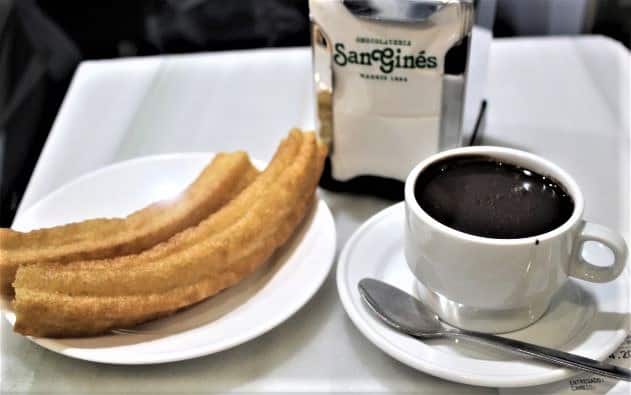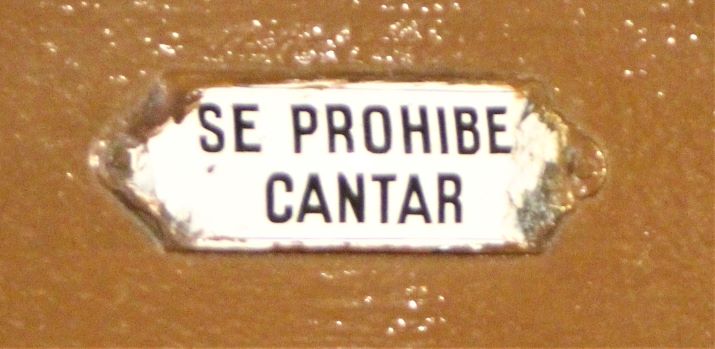The Spanish love their sweets. And, they are delicious. In fact, later in this article I will commit the unforgivable sin of putting a Spanish treat ahead of a similar French one (at least unforgivable to the French).
But, remember, you’ll order these sweet treats for breakfast, not after a meal for dessert.
So, here’s the must get sweets and drinks and the best place(s) to try them!
Porras
You might be familiar with the Churro, a dough that is squeezed through a star shaped nozzle and into a fryer to create a long, sweet, and crispy treat.
In Madrid, they eat Churros for breakfast, but they also have another option; the Porra. Porras are made with the same dough, but a wider nozzle is used to create something similar to a Churro, only fatter.
Hot Chocolate
Order a Churro or Porra with a cup of thick hot chocolate and dip your Spanish fried dough in the liquid. It’s very rich and decadent.

Chocolatería San Gines is the most famous place in Madrid to get Chrurros or Porras and for good reason. They’ve been in business since 1894. If you want to grab your Porras to go, stand in line at one entrance. Or, grab a table next door and look at the pictures of all the famous people who have dined and dunked before you. And, if you get a Porras craving at 3 in the morning, they’re open 24 hours a day, 7 days a week!
Napolitana de Chocolate
Spain may be famous for Churros con Chocolate, but frankly, I’m much more partial to another sweet treat in Madrid; Napolitana de Chocolate. It’s similar to France’s Pain au Chocolate. And, I know it’s probably heresy, but I like the Spanish version better. Don’t get me wrong, I like Pain au Chocolate very much. But, at La Mallorquina in Madrid, the croissant seems a bit flakier and, best of all, the chocolate inside is gooey, almost like a grenache.

Like I said, that might not be a popular opinion, but I’m calling ’em like I see ’em. Besides, La Mallorquina has been around since 1894 so they’ve got the Napolitana de Chocolate down.
Vermut de grifo (Vermouth on tap)
Forget everything you think you know about Vermouth. The Vermouth you get in Spain is a totally different animal than the drink your grandfather used to consume.
In Madrid, Vermouth is aged in barrels to give it flavor and caramel coloring. It is also infused with botanicals to give it flavor and aroma. Vermouth is served fresh on tap, straight up. Sometimes a slice of citrus and/or soda water is added.
Of course, you’re not likely to have Vermouth with a Napolitana de Chocolate, but I’ve included it because, well, why not, let’s enjoy ourselves!

Often, bars will have their own “Vermut Carero” or house made vermouth. They will add flavors like orange blossom or chile pepper to the Vermouth.
My favorite place for house made Vermouth is El 7 de la Cava. It’s a little hole in the wall with a rotating menu of Vermut Carero. Karen ordered the spicy one with that came with a slice of hot pepper on the side. It was too much for her so we traded (I ordered the Classico). In addition to a great selection of Vermouth, the atmosphere is chill and you get a little tapas with each drink you order (a practice that used to be customary, but now is more of a rarity in Madrid).

Another great spot is El Anciano Rey de los Vinos. They have good tapas with Vermut de grifo (Vermouth on tap).
And then there’s Casa Labra. Known for their fried cod tapas, they also have good Vermouth. On the wall of Casa Labra is a sign reading “Se Prohibe Cantar” (No Singing). The story I was told was that back in the day, people were not allowed to sing in bars. The reasoning went that singing could lead to more rowdy, drunken antics. In some places with a sense of humor, like Casa Labra, the sign remains. I’m sure no one is getting arrested for belting a verse of “Twist and Shout,” but just to be safe, I left my karaoke machine at home.

For more food and drink in Madrid and cool things to do in the city, check out our
About the Author

Brent Petersen is the Editor-in-Chief of Destination Eat Drink. He currently resides in Setubal, Portugal. Brent has written the novel “Truffle Hunt” (Eckhartz Press) and the short story collection “That Bird.” He’s also written dozens of foodie travel guides to cities around the world on Destination Eat Drink, including and in-depth eating and drinking guide to Portugal. Brent’s podcast, also called Destination Eat Drink, is available on all major podcasting platforms and is distributed by the Radio Misfits Podcast Network.
